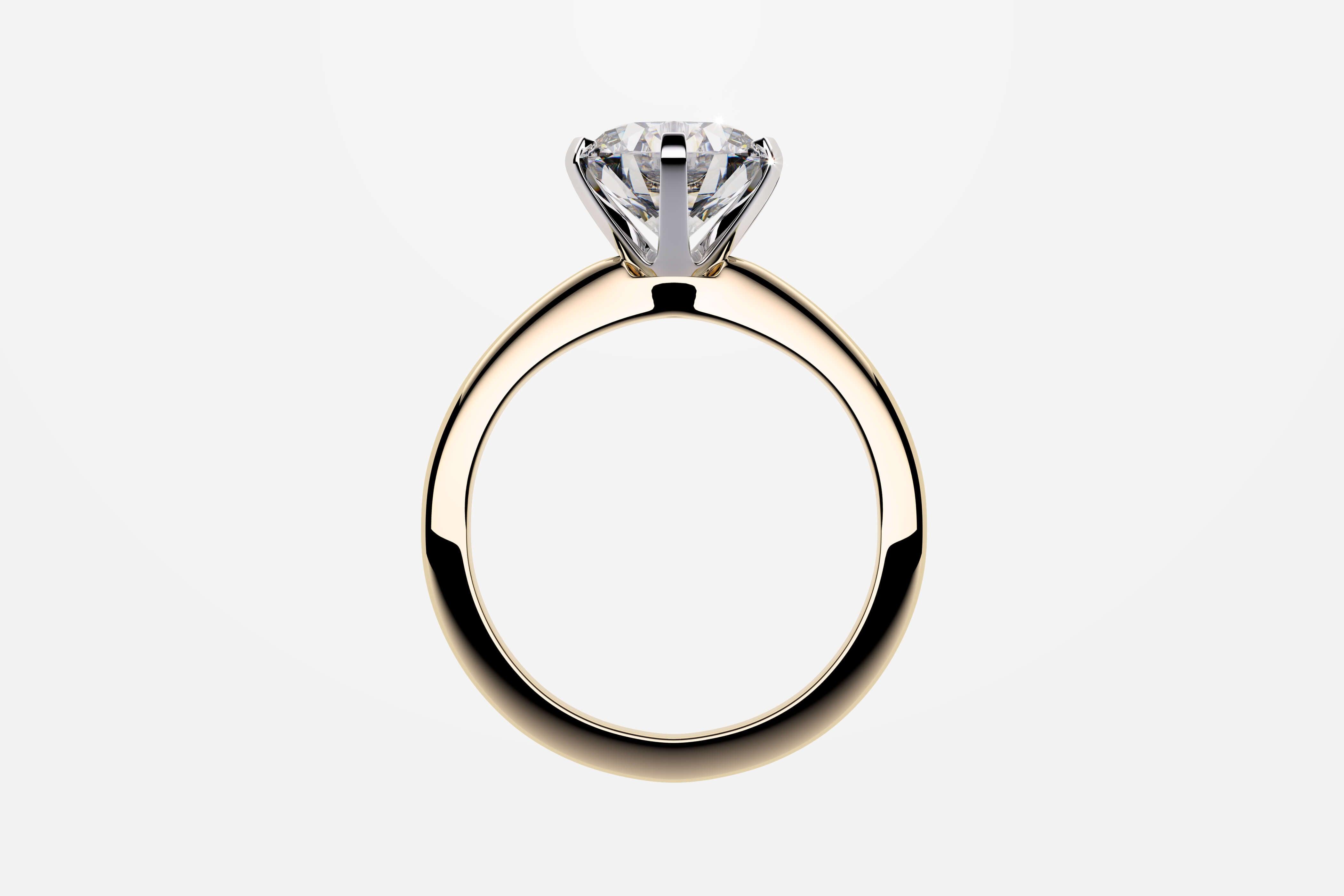
How to Choose an Engagement Ring Shank
Welcome to our next blog in Engagement Ring Basics, where we go over the information that will make selecting and purchasing the perfect engagement ring as easy and enjoyable as possible.
In other articles, we have covered bands, general ring anatomy, the 4 Cs, and precious metals such as white gold and platinum, traditional yellow gold, and rose/pink gold.
In our last blog, we discussed choosing a setting for your diamond engagement ring.
This time around, we will be discussing the shank of the band, the part that runs around the finger.
Choosing the right shank for your engagement ring is as important as choosing the right diamond. Not only will your ring’s shank have an impact on the exposition of the center stone, but it will also greatly impact your comfort.
Many of these styles and observations will be the same for wedding bands.
In this article we will cover:
- What is a ring shank?
- What is the best metal for engagement rings?
- Engagement ring details
- What is pavé, and what are melee diamonds?
- Engagement ring shank styles
What is a ring shank?
The part of the ring that wraps around your finger is called the shank of the ring. The shank is normally made of precious metals such as yellow gold, white gold, rose gold, and platinum.
Since we can look at the setting as the frame showcasing the center stone, we can call the band or shank the platform upon which it goes. Design features on the shank can have an impressive effect on how the setting and center stone will be viewed.
Artistic and decorative features can complement or contrast your ring.
Accents such as pavé, detailing, or the type of polish can add a sparkle to your ring or even make the center stone appear larger.
What is the best metal for an engagement ring?
The best ring metals tend to have similar qualities of both strength and style. The most common are gold and platinum alloys.
Pure gold is too soft to securely hold a stone, coming in around 2.5 on the Mohs hardness scale, so it is mixed with other metals to create a gold alloy of either 18k or 14k that is much stronger. Depending on what is used, the other metals may change the color tone, which is how white gold and rose/pink gold are developed. White gold and rose/pink gold are normally available in both 14k and 18k, though we recommend using 14k due to its greater strength and durability.
At 18k, white, rose and yellow golds are still pliable, but at around 2.8-3 on the Mohs scale, strong enough for some jewelry. Ranging between 3.5 and 4 on the Mohs scale, 14k alloys are extraordinarily tough and well suited for items of jewelry, such as engagement rings, that take more wear.
Platinum marks up at 4-4.5 on the Mohs scale, making it the strongest and most durable metal for engagement rings. Platinum for rings is rarely 100%pure, though many jewelers aim high, and at Michael Gabriels we use a 95% pure platinum.
Both platinum and white gold are often plated with Rhodium, another white metal. It is one of the strongest metals in the same group as platinum, riding high on the Mohs scale at a lofty number 6, making it more scratch resistant than any other metal normally used for diamond engagement rings. Plating with this gleaming and extremely hard precious metal keeps engagement rings in the best condition. Depending on how much wear the ring has sustained, re-plating tends to be about every ten years or so.
Karat, the universal measure of gold purity, should not be confused with carat weight, the universal measure of a diamond's weight.
Nor should Rhodium be confused with Radium, a radioactive element. That would be bad.
Yellow Gold:
The ultimate classic and for good reasons, yellow gold has held its popularity throughout the ages and is enjoying another rise today.
Besides its sun-colored shine, an advantage of yellow gold is that diamonds with a slight tint will look whiter when set in it.
Rose Gold:
With its pinkish hue, rose gold certainly is one of the most romantic of the metal varieties common in engagement rings. Achieved by combining gold, copper and sometimes other metals into an alloy, the sturdy metal and vibrant tone can make some forms of detailing pop more.
White Gold:
One of the most popular options today, white gold was developed in the early 20th century to make up for the limited availability of platinum. Similar in strength and appearance to platinum, it is not altogether much less expensive. One of the downsides is that it is not always as bright or as strong, though white gold alloys that include Palladium are actually stronger than platinum. They are also just as bright, requiring no Rhodium plating and very little maintenance over a lifetime.
Platinum:
Platinum is prized for its gleaming white shine and its strength and durability. While it was once both rare and difficult to work with, today almost any expert jeweler has the equipment necessary to work platinum, and it is mined and recycled extensively.
Silver
While silver was a popular choice in previous centuries for its white gleam, today it has largely been replaced by white gold and platinum, which are not only stronger, but also do not tarnish.
At Michael Gabriels, we do not offer silver for engagement rings.
Multi-tone rings
You might be asking the question: can I have more than one metal on my ring?
And the answer is “absolutely.”
There are a plethora of ways to mix and match metals in an engagement ring. Just as examples, you can have separate metals for the shank and for the head, or have more than one metal for the band. We are happy to work with you to find a way to get the tone of your engagement ring perfect.
Engagement Ring Shank Styles
Here are some of the most common and more popular kinds of shank styles out there.
Plain round/ Comfort fit Band
The most classic of bands, a plain strip of metal, rounded on the outer rim for comfort.
Knife-edge Shank
The band is wider on the inner edge (the one next to the finger) and narrows to a thin, rounded outer edge. This has more height than other settings.
Tapered Shank
The band is wider at the bottom and tapers as it reaches the setting, or vice versa, tapering down as it runs around the finger.
Bypass Shank
This band is a unique look, since it is not a continuous band around the finger. Instead, it splits at the head and one edge of the band goes on either side of the setting.
Split Shank
In this band style, the shank splits to surround the center stone and setting.
Twist Shank
The band is made of one or more twisted pieces of metal. This is a popular option for multi-tone rings.
Straight Shank
The band is flat on the top and has squared sides; it is essentially an elongated rectangular piece of metal. This shank is one of the best suited for holding trio pave.
Cathedral and Trellis
These band styles are unique in that they are also settings. What’s more, they can be combined with other band styles to produce something really unique. For example, you can combine a three-stone, split shank, pavé, and cathedral all into one.
Cathedral Shank
A classic look, the cathedral setting gets its name from the way the shank rises above the bridge and flanks the center stone like the flying buttresses of a gothic cathedral. This raises the center stone above the finger and can be designed to be very high, or only just above the bridge.
Trellis Shank
In a trellis setting the shank crosses below the center stone and wraps up around it, securing the diamond between its two arms.
What is Pavé, and what are melee diamonds?
Melee are tiny diamonds that are used for accenting and detail work on pieces of jewelry. Full-cut melee diamonds are less than 0.15 of a carat and still polished to the same 58 facets as full-size stones (when in round brilliant shape.) Melee can come in all the same shapes as larger diamonds.
When melee diamonds are set in a group or line they are generally called pavé. Pavé is a French word for paving, and describes how the melee diamonds are used.
Pavé is a way to dramatically increase the persona and sparkle of your piece and can be added to almost any part of the metal.
At Michael Gabriels most of our pavé are actually micro pavé settings, which simply means that the diamonds are really quite small and fitted together so that almost no metal shows, creating an almost seamless, glittering diamond overlay.
Single Pavé Band
The simplest way to incorporate pavé is as a single line running along part of the length of the band.
Slightly understated, this still achieves marks for glamor, though may be more appropriate if you live an active lifestyle.
Knife Edge Pavé
A variation of the knife edge shank, with pavé on each edge. Knife edge pavé adds a tasteful amount of visible gleam and glitter while also incorporating more metal to give a multi-tonal look to the band.
Trio Pavé
When pavé covers some part of three exposed sides of a shank, we call it trio pavé. Trio pavé will provide an exceptional amount of added scintillation to your engagement ring, with very little exposed metal, creating an almost solid paving of diamond.
How much pavé should you have?
The truth is that you should choose as much pavé as you think is right for you. That being said, keep in mind that pavé running all around the ring will make sizing not only extremely difficult, but also extremely expensive, and may require remaking the ring. We recommend pavé not farther than three quarters of the way down the band.
At Michael Gabriels, customers often ask for pavé in the amount of stones they want, such as 6 stone pavé, meaning three stones on each side of the band. That would run only about a quarter of the way down the band from the setting.
Engagement Ring Details
Filigree
An ornamental detailing in jewelry, filigree is essentially like a fine metal lacework. It can be used to create a basket or cage to hold a stone, to ornament a setting, or cover a band.A key feature characteristic of this form of metalwork is that the metal is soldered together and built up instead of being ground or chiseled away.
Millgrain
Milgrain are tiny beads soldered in rows and clusters on the metal band or setting. Typically used to create a subtle border, it has been a common feature on rings for centuries, and raises the surface of the metal on the ring, creating more texture and personality.
Chiseled/ Engraving
Engraving involved chiseling a design out of the metal, or otherwise removing metal to produce artistic designs.
Hammered Finish
Hammer finishes are a unique way to add personality to a ring. They are made by lightly hammering the surface of the metal to produce subtle impressions that break up the smooth surface and add texture and character to the band.
How can we help you?
At Michael Gabriels we have three generations and almost a century of experience at your disposal. We work with some of the most expert and experienced artisans here in New York City.
Let us put our expertise and experience to work for you to produce the perfect engagement ring.
We will work with you to find the perfect diamond, the perfect setting for it, and the perfect shank to hold it all. Our showroom is open, and it's easy to make an appointment, or just come walk in. We can also work with you long-distance. We have made engagement rings for people on three continents and counting.
All of our diamonds are lab-grown. We prefer them to mined diamonds since they are the exact same thing, only not dug out of the ground. And they are less expensive, which makes larger and more vibrant stones accessible to more people.
You can view our online collection and customize any piece you like however you want, or give us a call or message on Instagram and get started designing a piece from scratch today.



